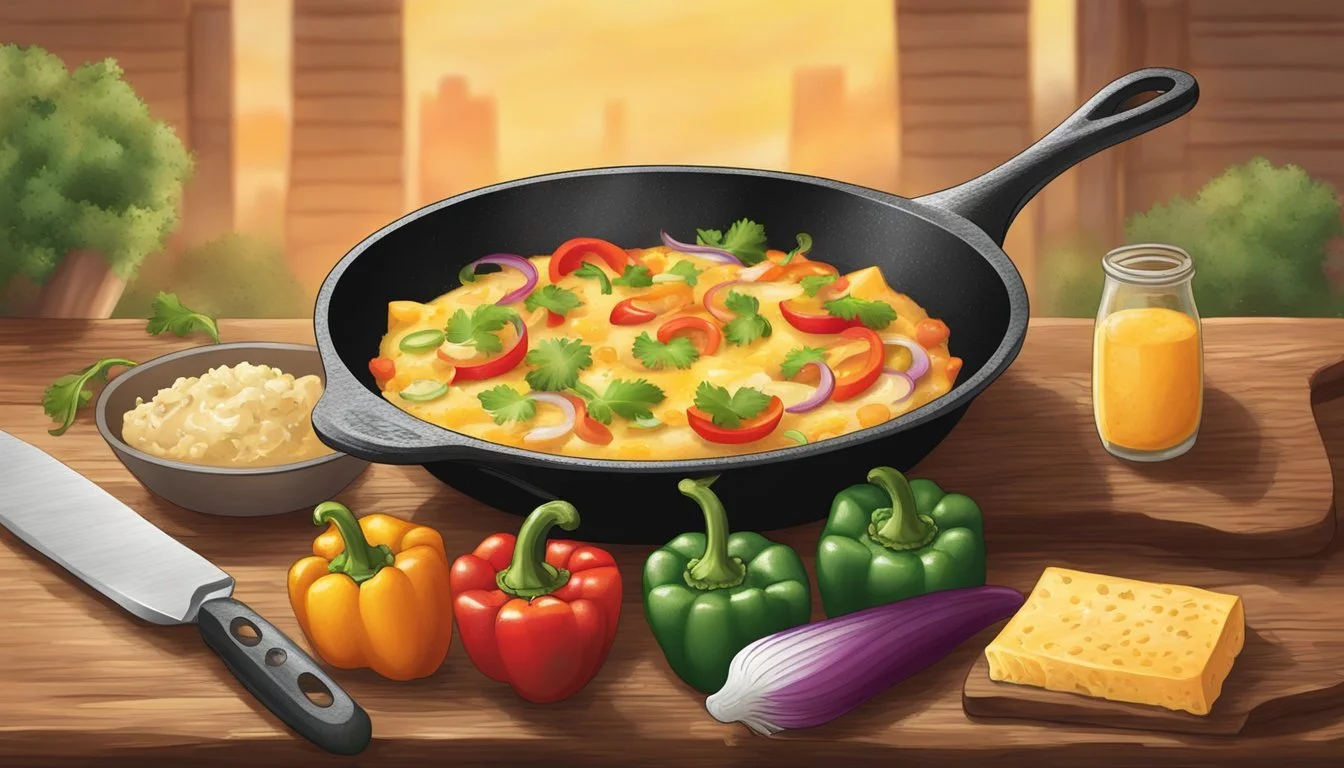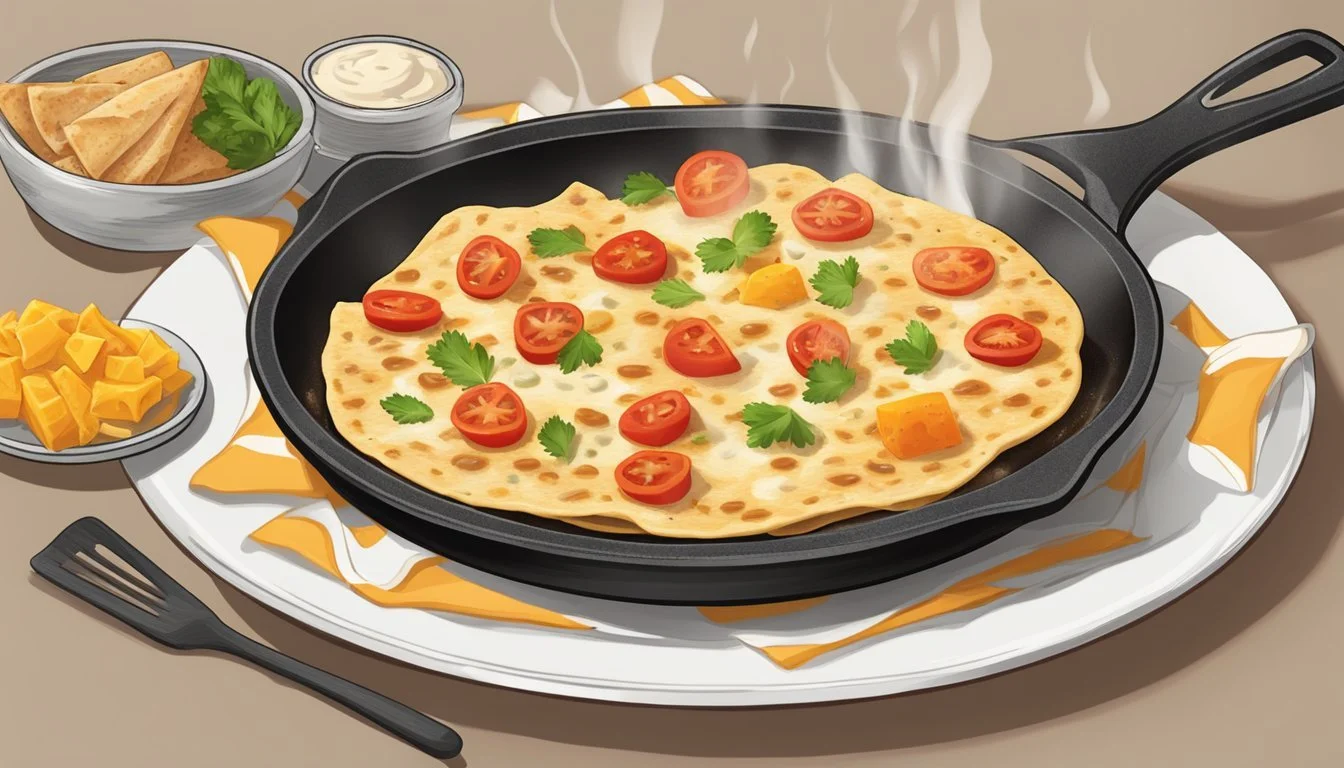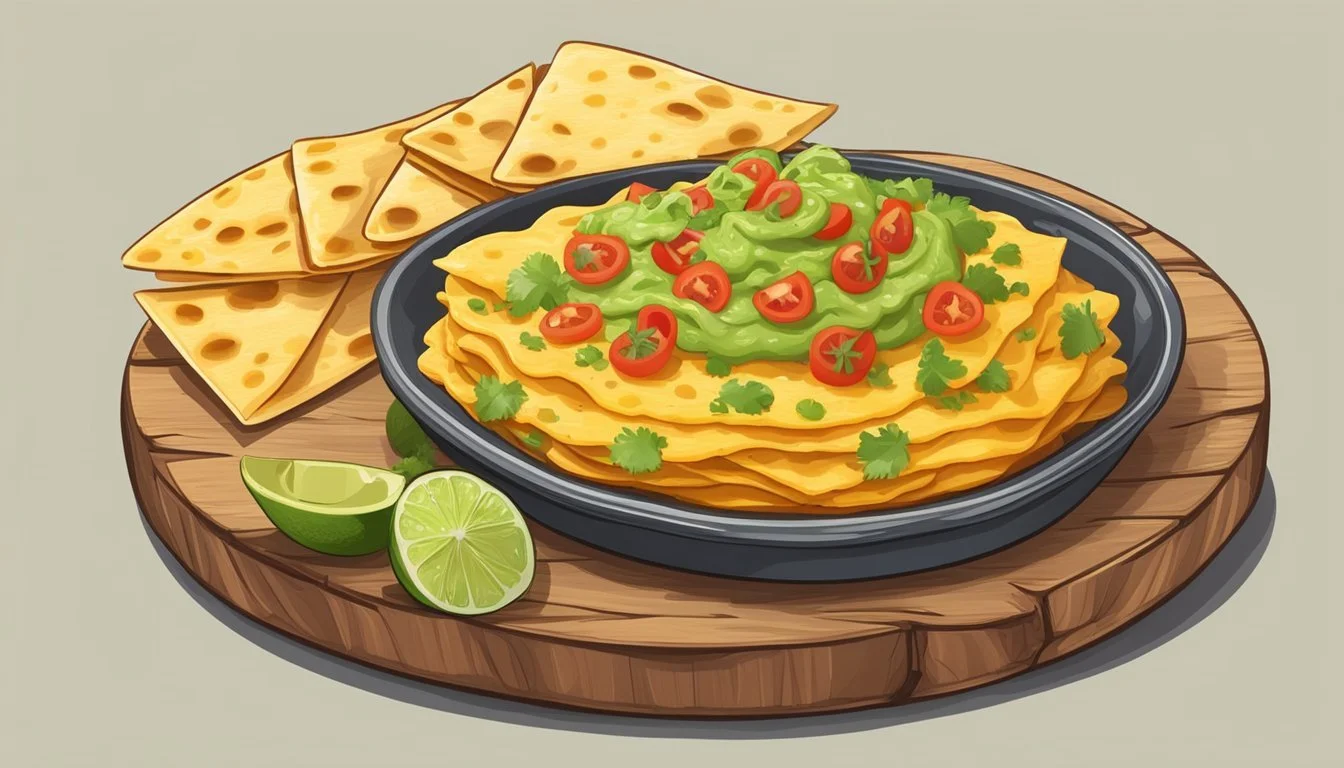Texas Quesadillas
A Culinary Journey Through Cheesy Delights
Discover > Truly Texan > Texas Quesadillas
Texas quesadillas, often celebrated for their robust flavors, bring a unique twist to the traditional Mexican favorite. They elevate chicken quesadillas with a blend of melted cheese (how long does cheese last?) pitted against the distinctive zing of barbeque sauce. The addition of caramelized onions augments the dish with sweetness, while a mixture of Cheddar and shredded Monterey Jack cheese balances the texture and taste with a creamy sour cream tang.
This Tex-Mex hybrid has emerged as a popular dish due to its versatility and ease of preparation, which is appreciated across the Lone Star State and beyond. A basic cheese quesadilla is a grilled tortilla filled with cheese, and the Texas version elevates this with its barbeque-inspired twist.
The fusion of flavors reflects the state's reputation for bold cuisine and its penchant for grilling and barbeque, making Texas quesadillas a staple at casual family gatherings and festive parties alike.
Accompaniments such as guacamole, sour cream, and chunky salsa often accompany Texas quesadillas, offering a cool and refreshing contrast to the warm, savory fillings and melted cheese inside.
These sides not only provide a balance of flavors but also allow individuals to customize each bite according to their preferences. Whether served as a main dish or a shareable appetizer, quesadillas are satisfying, adaptable, and unequivocally flavorful.
History and Origin
The chicken quesadillas' journey shares its roots with a traditional Mexican dish. This treat has evolved significantly from its humble beginnings, merging traditions and ingredients to become the beloved dish it is today.
The Roots of Quesadillas
Originating in Mexico, the quesadilla began as a simple meal consisting of a corn tortilla folded and filled with cheese (queso).
It dates back to the times when indigenous people in the south-central regions of Mexico cooked their food on hot griddles, known as comals.
Through the centuries, quesadillas have maintained their status as a staple in Mexican cuisine, with each region adding its own local ingredients to the filling, ranging from mushrooms to squash blossoms.
Texas Quesadilla
As Mexican culinary traditions migrated across the Rio Grande, Texas put its own stamp on the quesadilla. Tex-Mex cuisine, a fusion of American and Mexican foodways, gave rise to the Texan version, often featuring a flour (how long does flour last?) tortilla rather than the traditional corn.
Modern chicken quesadillas are typically larger, and heartier, and the quesadilla recipe contains a variety of fillings including meats like ground-beef fajita, chicken, and an assortment of vegetables, in addition to the quintessential cheese.
Essential Texas Quesadilla Ingredients
The Texas chicken quesadillas are a rich twist on traditional quesadillas, but the main ingredient is cheese. Texas versions used a variety of cheeses to create a creamy and melty consistency.
Common cheese choices include:
Monterey Jack Cheese: Smooth and mild, ideal for melting.
Pepper Jack Cheese: Adds a spicy kick with flecks of chili peppers.
Cheddar Cheese: A popular option that ranges from mild to sharp.
Oaxaca Cheese: A traditional Mexican cheese that melts easily and has a gentle buttery taste.
Proteins and Vegetables
A range of proteins and vegetables can be added to enhance the flavor of quesadillas:
One can choose between different types of meat, like shredded chicken breasts for a chicken quesadilla, or opt for a plant-based option such as black beans or kidney beans for protein.
Common vegetables include sautéed onions, green onions, and bell pepper, but the choice of veggies can vary according to what's in season and personal taste. Some prefer green onions, some prefer the sweeter red onion.
Preparation Techniques
When preparing chicken quesadillas Texas style, a great recipe, attention to assembly and cooking methods ensure a delicious outcome. The choice of oils and utensils plays a crucial role in achieving the desired texture and flavor, extra virgin olive is usually preferred.
Assembling the Quesadilla
To assemble a quesadilla, one starts by laying a flour tortilla flat on a clean surface. Cheeses, typically cheddar or Monterey Jack, are evenly spread on one half of the tortilla, leaving a small border to prevent spillage.
Cooked and shredded meats such as cooked chicken breasts, beef, or pork, along with any other desired fillings like bell peppers (What wine goes well with bell peppers?) or sautéed onion, are added on top of the cheese. The unfilled half of the tortilla is then folded over to create a half-moon shape.
Ingredients Placement:
Distribute the fillings evenly to ensure uniform melting and flavor.
Leave a border around the edge to seal the quesadilla properly.
Cooking Methods
You can pan-fry a chicken quesadilla with a large skillet, or comal, or use an oven. Each method adds a unique texture and flavor to the dish.
Skillet:
Heat a non-stick skillet over medium heat and lightly coat with vegetable oil (how long does vegetable oil last?), or extra virgin olive oil, or butter to prevent sticking.
Place the quesadilla in the skillet and cook until golden brown, then carefully flip to ensure even cooking on both sides.
Oven:
Preheat the oven to 400°F (200°C) and place the quesadilla on a baking sheet.
Bake until the cheese is melted and the tortilla is crispy, about 8-10 minutes.
Using the right amount of oil or butter not only prevents the quesadilla from sticking but also contributes to a crispy exterior. Whether one chooses to use a cast-iron skillet, a traditional comal, or an oven, monitoring the heat and cooking time is essential to avoid burning the tortillas or under-melting.
I highly recommend purchasing a skillet, olive oil, or vegetable oil, and baking sheet online for a convenient shopping experience!
Serving and Presentation
When it comes to serving Texas-style quesadillas, both the act of slicing and the choice of accompaniments are crucial for an enjoyable experience. Presentation is essential, as it enhances the overall appeal of these delicious treats.
Slicing and Plating
After cooking the quesadillas to a golden brown crispiness, they should be sliced into wedges to ensure easy handling and eating. The standard approach is to cut the quesadilla into thirds or quarters, depending on the size.
For large quesadillas: slice into sixths or eightths.
For smaller quesadillas: thirds or quarters suffice.
Each slice reveals the fillings, and it's best to plate and serve immediately, while they're hot, arranging the wedges in a circular pattern, typically with the points facing inwards, creating an attractive wheel of flavors.
Accompaniments
Chicken quesadillas are often served with a green salad or Spanish rice. The accompaniments served with your quesadilla can elevate an average chicken quesadilla recipe from simple to spectacular and some restaurants like to get creative with their own proprietary quesadilla dipping sauce.
Depending on where you go you could be in for some surprises but there are some common popular choices which are often presented in small bowls or spread around the platter for dipping.
Sour Cream
No Quesadilla is complete without a dollop of sour cream. Unless you are lactose intolerant or simply averse to the taste, sour cream is often appreciated alongside a quesadilla for its cool and tangy contrast against the warm spiciness of the quesadillas.
Salsa
Whether it's a classic tomato salsa or a fruit-based variant, the acidity and heat complement the richness of the filling. Traditionally the quesadilla salsa is made with fresh raw vegetables like tomatoes, garlic, and green peppers, the salsa is known in Mexico as pico de gallo.
Guacamole
Creamy avocado-based guacamole brings smoothness and a rich, nutty flavor to the dish.
Other Sauces
Barbecue Sauce: Especially in Texas, BBQ sauce adds a sweet and smoky dimension.
Jalapeño: Fresh or pickled jalapeño slices provide a burst of heat and a crunchy texture.
Cilantro: (how long does cilantro last?) Fresh cilantro lends a bright, herbal note that can freshen up each bite.
Honey: For those who prefer a sweet element, a drizzle of honey can balance spicier ingredients.
They might also garnish with thin slices of avocado and colorful red bell peppers, or sprinkle with cilantro leaves just before serving. Some diners appreciate the option of a wedge of lime to squeeze over their plate for a zesty finish.
Chicken Quesadilla Variations
Quesadillas are a customizable and versatile dish, although the chicken quesadilla is often crowned as king of the quesadillas by many, in Texas, they come with their own unique twists.
Texan quesadillas often feature bold combinations, stronger flavors, and hearty fillings.
Texas-Style Quesadillas
Texas-style quesadillas are a hearty take on the classic dish, often incorporating smoked meats (What wine goes well with smoked meats?) and bold cheeses. Pulled pork is a common filling, reflecting Texas's love for barbecue. This smoked meat blends wonderfully with smoked gouda, elevating the flavor profile with a robust taste. A classic chicken quesadilla in Texas might include rotisserie chicken for convenience and tenderness, mixed with spices like oregano and cayenne pepper for an extra kick. Other seasoning variations include; lemon juice, fresh cilantro, and hot sauce (how long does hot sauce last?).
Vegetarian Options
Vegetarian quesadillas don’t skimp on flavor with their vegetable filling, especially in the diverse culinary landscape of Texas. Key ingredients like black beans (how long do black beans last?) and corn provide a satisfying texture and are a staple in vegetarian variations. Cheese remains a cornerstone of the quesadilla, bringing everything together with its gooey goodness. Vegetables like onions and bell peppers are sautéed, sometimes giving the quesadilla a meaty essence without the meat.
Chicken Quesadilla Recipe Tips and Tricks
The success of a chicken quesadilla hinges on the mastery of cheese melting and the avoidance of common pitfalls. Any good quesadilla recipe can be poorly executed if you don't have a few tips and tricks up your sleeve. The following guidelines will help ensure that every quesadilla is deliciously cheesy and satisfyingly crisp.
Melting Techniques
Type of Cheese:
Use a blend of cheeses for optimal flavor and how well it melts. Sharp cheddar cheese pairs well with Monterey Jack cheese, which melts smoothly and provides the quintessential gooey texture. Some people add a herby cream cheese.
Avoiding Common Chicken Quesadilla Recipe Mistakes
Overfilling:
Resist the temptation to overfill quesadillas. A modest amount of filling alongside the shredded cheese ensures the quesadilla will cook evenly and prevent ingredients from spilling out during flipping.
Cooking Temperature:
Heat the skillet to a medium level. Cooking quesadillas on too high heat can burn the flour tortillas before the cheese has time to melt.
Patience in Flipping:
Wait until the cheese starts to melt before flipping the quesadilla. This helps the fillings bond, reducing the risk of the quesadilla falling apart.
Nutritional Information
Texas quesadillas are a popular dish that can vary widely in nutritional content based on their ingredients and preparation methods. The best chicken quesadillas come drenched in melty cheese and filling ingredients so you can expect high calories. This section examines their calorie content and considers dietary adjustments for different nutritional needs.
Calorie Count
A typical quesadilla with an 8-10 inch diameter can contain around 714 calories. These calories are derived from its key components:
Total Fat: 45g (58% Daily Value)
Carbohydrates: 47g (17% Daily Value)
Protein: Not specified in the search results, but typically present depending on the cheese and any additional protein added such as chicken.
It is important to note that the calorie count can fluctuate based on the size of the quesadilla and the choice of fillings like meats, beans, and vegetables.
Dietary Adjustments
For those monitoring their dietary intake or with specific restrictions, adjustments can be made:
Lower-Calorie Option: Use a smaller tortilla and reduce the amount of cheese. Adding vegetables can also increase the nutritional value while keeping calories in check.
Low-Carb Adjustments: Choosing a low-carb tortilla or even a lettuce wrap can significantly cut the carbohydrate content.
Dietary Fiber: Add beans or incorporate whole-grain tortillas to increase dietary fiber benefiting your digestive health.
Keep in mind that commercial Texas quesadillas can vary in saturated fat, monounsaturated fat, and polyunsaturated fat, so it’s advisable to check the nutritional information for each specific restaurant or brand.
Cultural Significance
The cultural significance of Texas quesadillas extends beyond mere cuisine, bridging the intricate flavors of Mexican heritage with the hearty essence of Texan fare.
They serve not only as a culinary delight but also as a medium for social connection and cultural identity within communities.
Quesadillas in Cuisine
Texas quesadillas are a staple representation of Tex-Mex cuisine, a regional culinary tradition that blends Mexican and American tastes.
Characterized by the generous use of melted cheese, typically a cheddar cheese or Monterey Jack, these quesadillas distinguish themselves through their rich, bold flavors.
They often incorporate ingredients like beef brisket, a Texan favorite, fusing traditional Mexican culinary methods with Texas’s barbeque culture.
Main components: Tortillas, cheese, various meats (often Texan barbeque), spices.
Cooking style: Grilled or cooked on a flat top, allowing for a crispy texture.
Family and Community Gatherings
In Texas communities, quesadillas are more than just food; they symbolize family and togetherness.
During family gatherings or community events, the act of preparing and sharing quesadillas is a social ritual that reinforces bonds.
Communal aspect: Shared platters of quesadillas encourage communal dining experiences.
Festive occasions: Celebrations often feature quesadillas, not only as a dish but also as a part of cultural expression, embodying the warmth and hospitality inherent to both Texan and Mexican traditions.
Home Cooking Vs. Restaurant Style
When making quesadillas at home, one has the freedom to experiment and personalize the dish to their taste, whereas restaurant-style quesadillas strive for consistent quality and often use specific techniques to achieve a distinct flavor and presentation such as artistic, decorative garnishes made of red, yellow and green bell peppers.
The choice between the two styles can influence the taste, texture, and overall enjoyment. Homemade twists can make this recipe into the best chicken quesadillas.
Making Chicken Quesadillas at Home
Everyone can appreciate the versatility that comes when you make a quesadilla at home, they aren't too complex, and they require just a few ingredients even an unseasoned home cook can make this recipe.
They have the liberty to select from a variety of ingredients, allowing for customized recipes that cater to personal preferences or dietary restrictions.
Home cooking generally equates to healthier adaptations with control over aspects like the amount of cheese and type of meats used.
Ingredients One Might Use:
Cheese (e.g., cheddar, Monterey Jack cheese)
Meats (e.g., grilled chicken, pan-fried beef)
Vegetables (e.g., bell peppers, onions)
A basic home chicken quesadilla recipe might involve a simple cheese and meat combination, but one could also incorporate ingredients like poached or braised chicken, which can be shredded to ensure the quesadilla is not soggy. You can switch out the bell peppers for aubergines and zucchinis, or simplify the seasoning with store-bought fajita or taco seasoning (how long does taco seasoning last?).
Restaurant-Quality Techniques
Restaurants tend to apply specific cooking methods to reach a professional level of taste and texture. This includes using high-quality wheat flour, cheeses, meats, and vegetables.
Techniques to Achieve Restaurant Style:
Use of multi-cheese blends for depth of flavor
Grilling or frying for a crispy exterior
Consistent ingredient proportions for uniformity
While white wine is not a traditional quesadilla ingredient, some chefs might deglaze pans with it when cooking meats to add an unconventional, complex flavor to a restaurant-style quesadilla.
It’s these kinds of innovative approaches that distinguish restaurant quesadillas from their home-cooked counterparts.
Frequently Asked Questions
In exploring the world of Texas quesadillas, enthusiasts often have questions regarding preparation, types of tortillas, and ingredient choices. This section aims to clarify common curiosities and address more complex concerns related to quesadillas.
What type of tortillas are used for Texas quesadillas?
Texas quesadillas traditionally utilize both flour tortillas and corn tortillas. Flour tortillas are known for their flexibility and larger size, making them ideal for a standard quesadilla, while corn tortillas offer a distinct flavor and texture, characteristic of the cuisine. Gluten-free alternatives can be used to cater to dietary needs.
What are the essential ingredients for a classic Texan quesadilla?
One must gather cheese—typically a melting variety such as cheddar or Monterey Jack—alongside a choice of fillings which may include meats like beef or shrimp, and vegetables like black beans and corn. Various spices and condiments such as salsa add flavor depth which might include over-the-counter taco seasoning or your favorite hot sauce.
How does one achieve the perfect cheese melt in a quesadilla?
The key lies in the heat level and cooking time. For a perfect melt, one should cook the quesadilla over medium heat and allow the cheese to slowly reach a gooey state, which typically occurs in a span of a few minutes on each side. Freshly grated cheese works best pre-shredded cheese can have calcium coating to prevent clumping and won't melt as well as fresh shredded Monterey Jack.
Are there any non-traditional ingredients that can enhance a Texan quesadilla?
While the classic components are beloved, one might experiment with contemporary twists, like using marinated proteins—such as ancho chile shrimp—or incorporating tofu or vegan cheese to cater to dietary preferences while still maintaining the quintessential quesadilla essence. Many people switch out the bell pepper for other favored vegetables.








